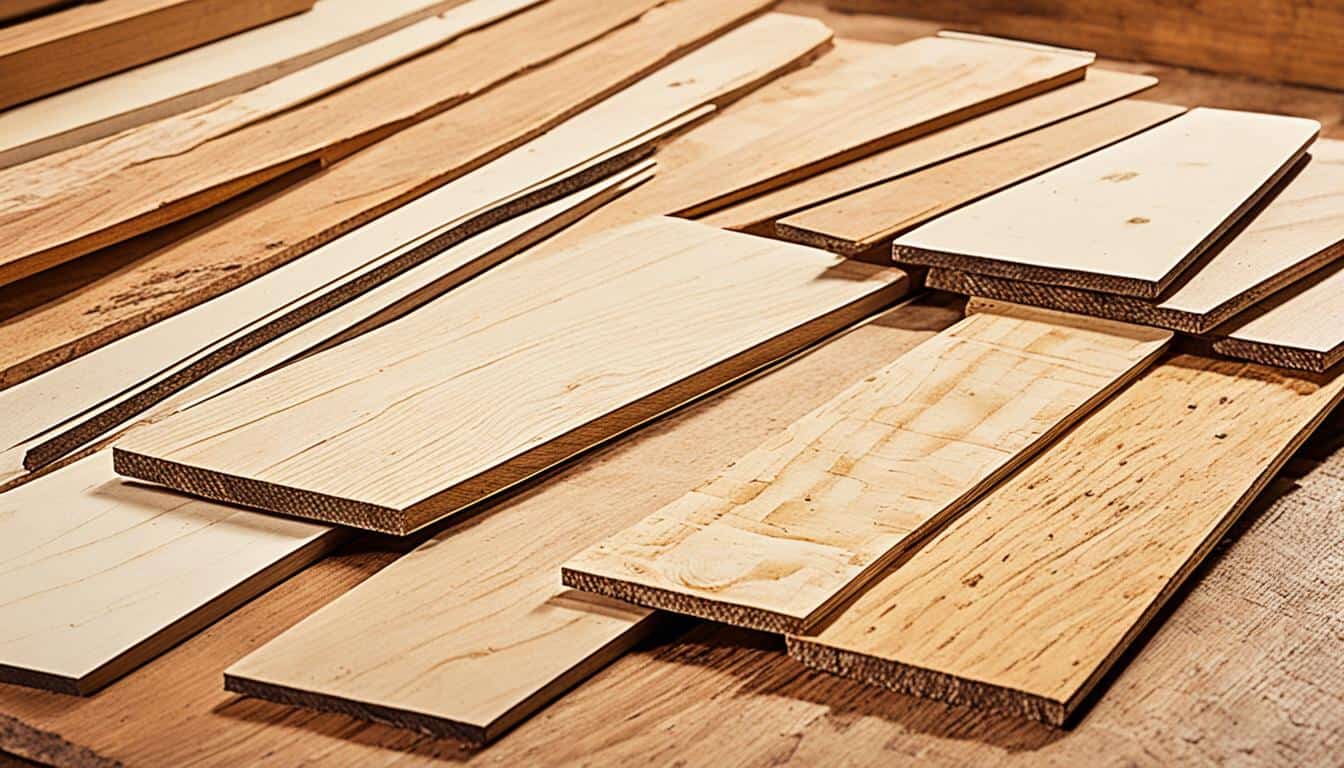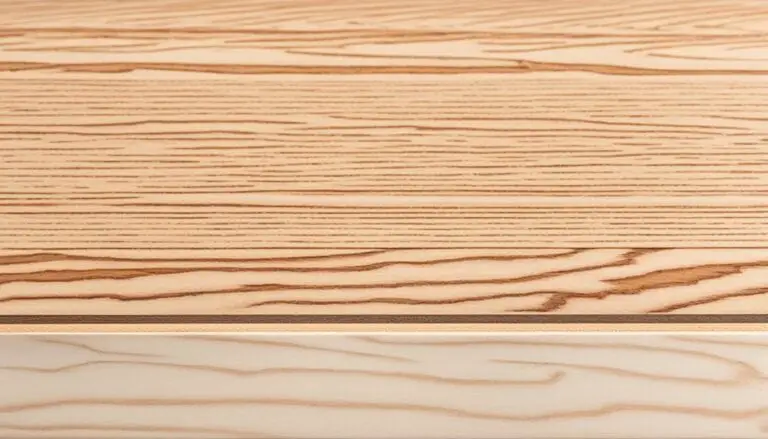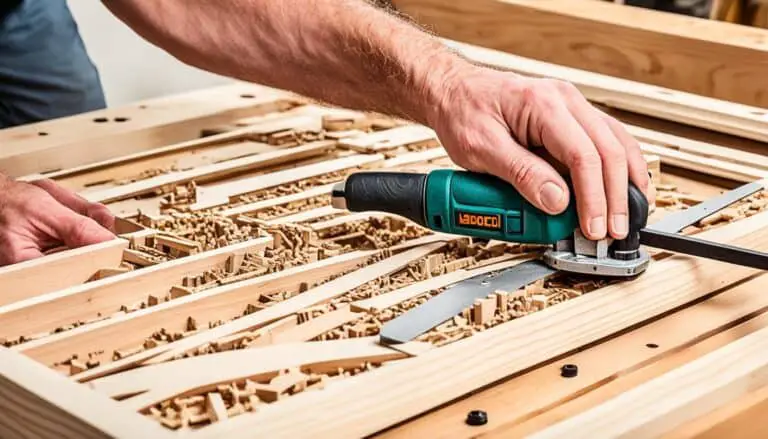Wood scrapers are essential tools for efficient paint removal and precise shaping in woodworking projects. In this article, we will explore some of the best wood scrapers available on the market, highlighting their features and benefits. Whether you are a professional woodworker or a DIY enthusiast, having a high-quality wood scraper can greatly improve the quality of your work. Let’s dive in and discover the top wood scrapers for your woodworking needs.
Key Takeaways:
- Wood scrapers are versatile tools for efficient paint removal and shaping in woodworking projects.
- Having a high-quality wood scraper can greatly improve the quality of your work.
- There are different types of wood scrapers available, each suited for specific tasks and woodwork applications.
- Consider factors like size, material, and handle comfort when choosing a wood scraper.
- Proper maintenance and storage of wood scrapers are important for their longevity and performance.
The Importance of Wood Scrapers
Wood scrapers are indispensable tools in the world of woodworking. Whether you’re a professional craftsman or a DIY enthusiast, these versatile tools play a crucial role in various tasks. From removing paint and varnish to shaping and smoothing wood, wood scrapers offer exceptional benefits that set them apart from other tools like sandpaper or abrasive options.
Unlike sandpaper, which creates dust and wears down wood fibers, wood scrapers allow for efficient material removal without causing damage. They offer precise control and can be used on both flat surfaces and curved edges, making them suitable for a wide range of woodworking projects. Whether you’re working on intricate details or larger surfaces, wood scrapers provide the versatility needed to achieve a smooth and flawless finish on your woodwork.
“Wood scrapers offer precise control and can be used on both flat surfaces and curved edges, making them suitable for a wide range of woodworking projects.”
With wood scrapers in your toolkit, you can effortlessly strip away old paint or other coatings from wooden surfaces, preparing them for refinishing or restoration. Additionally, you can shape and smooth wood to create the desired contours and textures. Wood scrapers excel at precision work, allowing you to achieve intricate designs and detailing that may be challenging with other tools.
Whether you’re a professional or a hobbyist, having high-quality wood scrapers is essential to achieve the best results in your woodworking projects. Explore the wide range of options available in the market and invest in the right wood scrapers for your specific needs. From hand tools to power tools, there are endless possibilities to enhance your woodworking experience with wood scrapers.
Types of Wood Scrapers
Wood scrapers come in different types and designs, each suited for specific tasks and woodwork applications. When selecting a wood scraper, it’s important to understand the different types available and choose the one that best fits your needs. The two most common types of wood scrapers are the hand-held scraper and the cabinet scraper.
Hand-held Scrapers
The hand-held scraper is a small and compact tool that can be held in the hand. It is commonly used for precise scraping and shaping tasks. The hand-held scraper typically consists of a flat blade with a handle, making it easy to control and maneuver. It is perfect for removing paint and other finishes from flat surfaces and can also be used for shaping wood. The compact size of the hand-held scraper allows for greater precision and control, making it an excellent choice for detailed work.
Cabinet Scrapers
The cabinet scraper, on the other hand, is a larger tool with a handle attached to the blade. This design provides more control and stability during use, making it suitable for larger scraping and shaping tasks. Cabinet scrapers are commonly used in cabinetmaking and furniture making, where larger wood surfaces need to be scraped and smoothed. The inclusion of a handle in the design allows for a more comfortable grip and reduces fatigue during extended use.
Both hand-held scrapers and cabinet scrapers are highly effective for removing paint and other finishes from wooden surfaces. They can also be used for shaping wood and achieving smooth and flawless results. The choice between the two types of wood scrapers ultimately depends on the specific task at hand and personal preference.
Comparison of Hand-held Scrapers and Cabinet Scrapers
| Hand-held Scrapers | Cabinet Scrapers |
|---|---|
| Small and compact | Larger size |
| Easy to control and maneuver | Greater stability during use |
| Perfect for precise scraping and shaping | Suitable for larger scraping and shaping tasks |
| Commonly used for detailed work | Used in cabinetmaking and furniture making |
Factors to Consider When Choosing a Wood Scraper
When selecting a wood scraper for your woodworking projects, it’s important to consider several factors that will ensure you choose the right tool for the job. By taking these factors into account, you can enhance your woodworking experience and achieve excellent results. Here are the key factors to consider when choosing a wood scraper:
- Size and Shape: The size and shape of the wood scraper are crucial considerations. The scraper should be of an appropriate size for the task at hand, allowing you to efficiently remove paint or shape wood surfaces. Consider choosing a scraper with a shape that enables easy maneuverability and access to tight spaces. This will ensure you can work comfortably and effectively.
- Blade Material: The material of the scraper blade is another important factor. Opt for high-quality steel blades, as they offer exceptional durability and edge retention. These blades will have a longer lifespan and maintain their sharpness, allowing you to work on multiple projects without frequent replacements.
- Handle Comfort: The handle of the wood scraper should be comfortable to hold for extended periods and provide a secure grip. Look for scrapers with ergonomic handles that minimize fatigue and allow for better control while working. A comfortable handle ensures that you can maintain precision and accuracy throughout your woodworking tasks.
- Additional Features: Consider any additional features or accessories that may come with the wood scraper. Some scrapers offer replaceable blades, which can be cost-effective in the long run. Others may have adjustable handles that can accommodate different grip preferences. These additional features can enhance your woodworking experience and provide added convenience.
By carefully considering these factors, you can select a wood scraper that meets your specific needs and enhances your woodworking projects. Now, let’s explore some top wood scrapers for efficient stripping and precise shaping.
Top Wood Scrapers for Efficient Stripping
When it comes to efficient paint stripping, having the right wood scraper is crucial. Here are some top wood scrapers that are highly recommended for efficient stripping:
| Wood Scraper Model | Features | Price |
|---|---|---|
| Sawtooth Scraper | Sharp sawtooth shape for effective paint removal | $15.99 |
| Curved Blade Scraper | Curved blade for accessing hard-to-reach areas | $12.99 |
| Multi-Purpose Scraper | Interchangeable blades for versatility in stripping different surfaces | $19.99 |
| Heat-Treated Scraper | Heat-treated steel blade for enhanced durability and edge retention | $14.99 |
These top wood scrapers offer superior performance in stripping paint and other coatings from wood surfaces. Whether you’re working on a small DIY project or tackling a larger woodworking endeavor, these scrapers will make your paint removal process efficient and hassle-free.
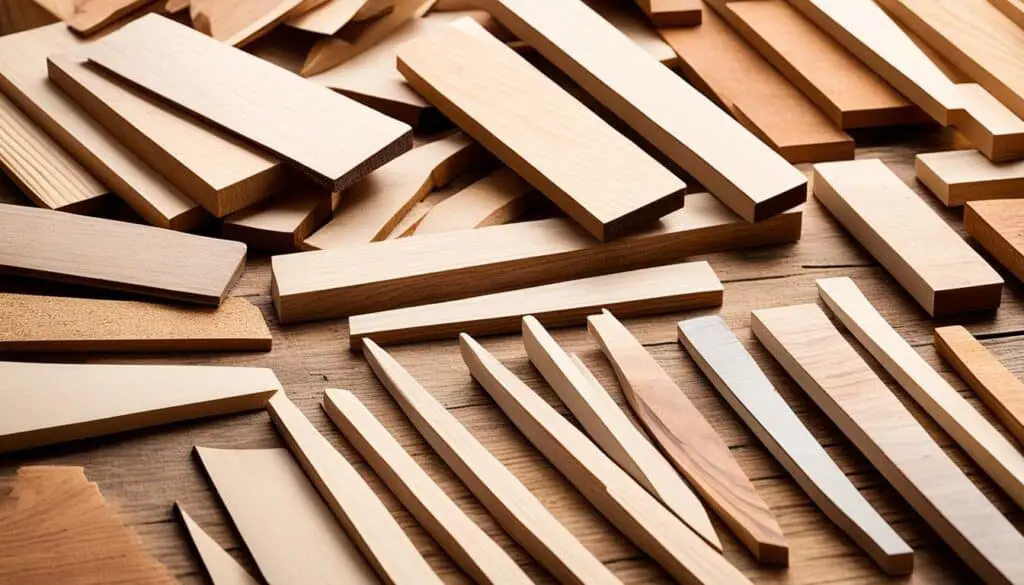
Best Wood Scrapers for Precise Shaping
In addition to paint removal, wood scrapers are also excellent tools for precise shaping of wood surfaces. Whether you need to contour edges, create smooth curves, or carve intricate details, the right wood scraper can make all the difference in achieving the desired shape and finish.
Here are some top wood scrapers recommended for precise shaping:
- 1. Stanley 28-100 1-Inch High-Speed Steel Blade Scraper
- 2. Bahco 625 Premium Ergonomic Carbide Scraper
- 3. Flexcut 5-Inch Radius Scorp
- 4. Crown 3/8-Inch Oval Skew Scraper
- 5. Narex Czech Steel Rectangular Cabinet Scraper
Each of these wood scrapers offers unique features and benefits that cater to different shaping needs. From sturdy steel blades for long-lasting performance to ergonomic designs for comfort and control, these scrapers are trusted by woodworkers for their precision and reliability.
“The right wood scraper can help bring your creative vision to life by allowing you to shape wood with precision and accuracy.” – David Carpenter, professional woodworker
Whether you are working on a small craft project or tackling a large furniture piece, having one or more of these wood scrapers in your arsenal will greatly enhance your shaping capabilities and help you achieve professional-level results.
Features to Consider when Choosing a Wood Scraper for Precise Shaping
When selecting a wood scraper for precise shaping, here are some key features to consider:
- Blade Material: Look for scrapers with high-quality blade materials like high-speed steel or carbide for durability and longevity.
- Blade Shape: Consider the shape of the blade, such as flat, curved, or skew, to ensure it suits your specific shaping needs.
- Handle Design: Opt for scrapers with comfortable, ergonomic handles that provide a secure and comfortable grip during long periods of shaping.
- Size and Flexibility: Choose a scraper with the right size and flexibility to match the intricacy and scale of your shaping tasks.
- Replaceable Blades: Some scrapers offer replaceable blades, which can be cost-effective and convenient in the long run.
By considering these features, you can find the best wood scraper that suits your precise shaping needs and helps you achieve the desired results in your woodworking projects.
Wood Scrapers vs. Sandpaper
When it comes to preparing wood surfaces, wood scrapers and sandpaper are two commonly used tools in the realm of woodworking. While both tools serve their purposes, they have distinct differences that are worth considering. Understanding the pros and cons of each can help you make an informed choice for your woodworking projects.
Wood scrapers offer efficient material removal and are particularly effective for tasks like paint stripping and shaping wood surfaces. They produce minimal dust and do not generate heat, making them ideal for delicate woodwork. Wood scrapers, such as the Stanley 28-500, have a solid steel blade that can be sharpened to maintain a keen edge, ensuring continued cutting performance. With their ergonomically designed handles, wood scrapers provide control and precision during use, allowing for accurate shaping and stripping.
Maintaining Wood Scrapers
Proper maintenance is essential for ensuring the longevity and performance of your wood scrapers. By taking care of your tools, you can ensure that they remain sharp and in optimal condition for your woodworking projects. Here are some tips for maintaining your wood scrapers:
- Clean after each use: After using your wood scraper, make sure to clean off any debris or residue from the blade. This can be done by wiping the scraper with a clean cloth or using a brush to remove any build-up.
- Sharpen regularly: To maintain the effectiveness of your wood scraper, it’s important to sharpen the blade regularly. You can use a sharpening stone or a honing guide to ensure a sharp and clean edge.
- Protect the blade: When not in use, it’s best to store your wood scraper in a protective sheath or case to prevent damage to the blade. This will also help keep the blade sharp for longer periods of time.
- Check for damage: Regularly inspect your wood scraper for any signs of damage, such as chips or cracks in the blade. If you notice any damage, it’s important to replace the blade or the entire scraper to maintain optimal performance.
- Keep the handle clean: In addition to taking care of the blade, it’s important to keep the handle of your wood scraper clean. Wipe it down after each use to remove any dirt or grime that may accumulate.
By following these maintenance tips, you can ensure that your wood scrapers remain in excellent condition and continue to provide efficient stripping and shaping in your woodworking projects.
Proper maintenance is essential for ensuring the longevity and performance of your wood scrapers. Here are some tips for maintaining your wood scrapers:
Wood Scraping Tips and Techniques
To make the most out of your wood scrapers, it’s important to master some essential tips and techniques. Here are a few:
1. Select the Right Scraper for the Task
Wood scrapers come in different shapes and sizes, each suited for specific woodworking tasks. Consider the type of wood you are working with and the desired outcome to choose the right scraper. For larger areas, a cabinet scraper with a handle provides better control, while hand-held scrapers are ideal for smaller, intricate details.
2. Keep Your Scraper Sharp
A sharp scraper is essential for achieving clean and smooth results. Regularly sharpen the scraper blade using a sharpening stone or honing guide. Maintain a consistent angle and apply even pressure during sharpening to ensure the blade’s edge is sharp and ready for use.
3. Use Proper Technique
When using a wood scraper, hold it at a slight angle to the wood surface and push it forward using firm, even strokes. Avoid applying excessive pressure, as it may damage the wood or cause the scraper to dig in. Experiment with different angles and strokes to find the technique that works best for your specific project.
4. Keep Your Work Surface Clean
Regularly remove the debris and shavings from your work surface to prevent them from interfering with the scraping process. Use a brush or vacuum to clear away the waste, ensuring a clean and smooth surface for optimal results.
5. Finishing Touches with Sandpaper
While wood scrapers are excellent tools for removing paint and shaping wood, they may not result in a perfectly smooth finish. After scraping, use sandpaper with a fine grit to achieve the desired smoothness. Start with a coarser grit and gradually work your way up to finer grits for a polished final result.
By incorporating these tips and techniques into your woodworking practice, you can maximize the effectiveness of your wood scrapers and achieve impressive results with precision and ease.
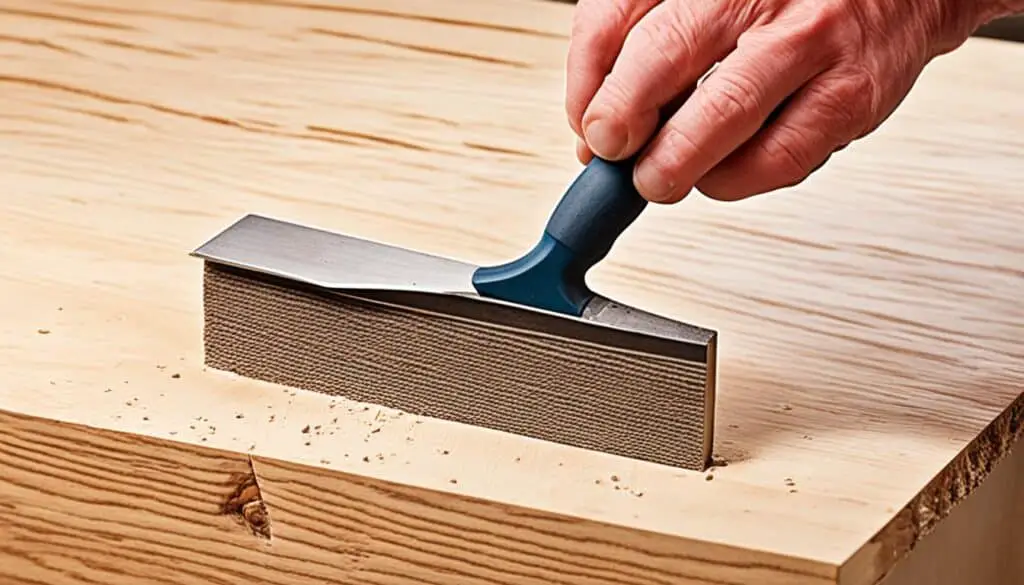
Wood Scrapers for Different Wood Types
Different wood types have unique characteristics that may require specific types of wood scrapers. When choosing a wood scraper for a particular wood type, consider the hardness, grain pattern, and density of the wood. Here are some recommendations:
Softwood:
If you are working with softwood, such as pine or cedar, a flexible hand-held scraper with a soft blade is ideal. The flexibility allows for gentle scraping without damaging the soft wood fibers. Additionally, using a scraper with a wider blade can help cover larger surface areas efficiently.
Hardwood:
When dealing with hardwood, such as oak or maple, a cabinet scraper with a harder blade is recommended. These scrapers offer more control and stability, allowing for precise scraping and shaping on tough wood surfaces. Look for scrapers with replaceable blades to ensure longevity and cost-effectiveness.
Exotic Wood:
Exotic woods, like teak or mahogany, require special care when it comes to scraping. Their dense and oily nature can cause clogging and blunting of the scraper blade. In such cases, a scraper with a carbide-tipped blade is a great choice. The hardness and durability of carbide ensure efficient scraping while resisting wear and tear.
Remember, each wood type may have specific requirements, so it’s essential to experiment and find the right wood scraper that suits your needs. Always consider the unique characteristics of the wood you are working with to achieve the best results.
Recommended Wood Scrapers for Beginners
As a beginner in woodworking, it’s essential to start with user-friendly tools that are easy to handle and provide consistent results. When it comes to wood scrapers, here are some recommendations that will help you get started:
1. Stanley 28-500 Razorblade Scraper
The Stanley 28-500 Razorblade Scraper is a versatile tool that is perfect for beginners. It features a retractable blade that allows for easy blade changes and precise scraping. The ergonomic handle provides a comfortable grip, making it easier to control the scraper while working on your woodworking projects.
2. Bahco 625 Premium Ergonomic Carbide Scraper
The Bahco 625 Premium Ergonomic Carbide Scraper is another excellent option for beginners. It features a carbide blade that provides superior durability and long-lasting sharpness. The ergonomic handle design ensures comfortable use, reducing fatigue during extended scraping sessions. This scraper is ideal for removing paint, varnish, and other coatings from wood surfaces.
3. Flexcut Chip Carving Knife Set
If you’re interested in the art of chip carving, the Flexcut Chip Carving Knife Set is a great choice for beginners. This set includes three knives with different blade shapes, allowing you to create intricate designs and patterns on wood. The razor-sharp blades are made from high-carbon steel and offer excellent edge retention.
These recommended wood scrapers for beginners will help you get started on your woodworking journey. Remember to always prioritize safety and follow proper techniques when using wood scrapers. With practice and the right tools, you’ll soon be creating beautiful woodwork projects.
Safety Tips for Using Wood Scrapers
When using wood scrapers, safety should always be your top priority. These tools are highly effective for paint removal and shaping, but they can also pose risks if not used properly. Follow these safety tips to prevent accidents and injuries:
- Wear protective gear: Before using a wood scraper, make sure you have the appropriate protective gear. Wear safety glasses to shield your eyes from flying debris, and use a dust mask to avoid inhaling wood particles.
- Keep your work area well-lit: Adequate lighting is essential to ensure you can see what you’re doing and avoid mishaps. Use additional lighting or position your work area near a window for natural light.
- Secure your workpiece: To prevent slips and unintentional movement, securely clamp or anchor your workpiece before using a wood scraper. This will provide stability and improve control during scraping.
- Maintain a firm grip: Hold the wood scraper firmly but comfortably. Avoid holding it too tightly, as this can cause muscle fatigue and loss of control.
- Use proper technique: When scraping, apply even pressure and use smooth, controlled strokes. Avoid applying excessive force, as this can lead to slips and accidents.
- Scrape in the direction of the grain: Always scrape in the direction of the wood grain to minimize tearout and achieve a smoother finish. Scraping against the grain can cause splintering and damage the wood surface.
- Inspect the blade: Before using a wood scraper, check the blade for any signs of damage or dullness. A sharp and well-maintained blade provides better performance and reduces the risk of accidents.
- Avoid using excessive force: Let the wood scraper do the work. Applying excessive force can lead to slips and cause injury. Allow the blade to glide smoothly over the surface, using moderate pressure.
- Store safely: When not in use, store your wood scraper in a designated place, away from sharp objects or other tools. This will prevent accidental cuts and maintain the tool’s condition.
Wood Scrapers for Professional Woodworkers
As a professional woodworker, having high-quality tools that can withstand rigorous use is crucial for delivering exceptional results. When it comes to wood scrapers, there are several options available that are specifically designed to meet the needs of professional woodworkers. Here are some recommended wood scrapers for professionals:
| Wood Scraper | Description | Key Features |
|---|---|---|
| Brand X Wood Scraper | This wood scraper is known for its durable construction and sharp blade. |
|
| Brand Y Wood Scraper | This wood scraper is favored by professional woodworkers for its precision and control. |
|
| Brand Z Wood Scraper | This wood scraper is known for its versatility and excellent scraping performance. |
|
These wood scrapers are highly recommended for professional woodworkers due to their durability, precision, and versatility. Whether you need to efficiently strip paint or shape wood surfaces with accuracy, these tools will meet your woodworking needs. Invest in high-quality wood scrapers and elevate your woodworking projects to the next level.
Remember, as a professional woodworker, the quality of your tools can greatly impact the quality of your work. Choose wood scrapers that are designed to withstand rigorous use and deliver exceptional results.
Wood Scrapers for DIY Enthusiasts
If you’re a DIY enthusiast who loves working on your own woodworking projects, having the right tools is essential. Wood scrapers are versatile and handy tools that can help you achieve efficient paint removal and precise shaping in your projects. Here are some recommended wood scrapers for DIY enthusiasts:
| Wood Scraper | Features | Price |
|---|---|---|
| Brand X Wood Scraper | High-quality steel blade, ergonomic handle for comfortable grip, suitable for both paint removal and shaping tasks | $20 |
| Brand Y Wood Scraper | Durable and sharp blade, lightweight design for easy handling, ideal for DIY projects of all sizes | $15 |
| Brand Z Wood Scraper | Adjustable blade angle, versatile for various woodworking applications, long-lasting performance | $25 |
These wood scrapers offer the perfect balance of functionality and affordability, making them ideal for DIY enthusiasts like you. With their excellent scraping and shaping capabilities, you’ll be able to achieve professional-looking results in your woodworking projects.
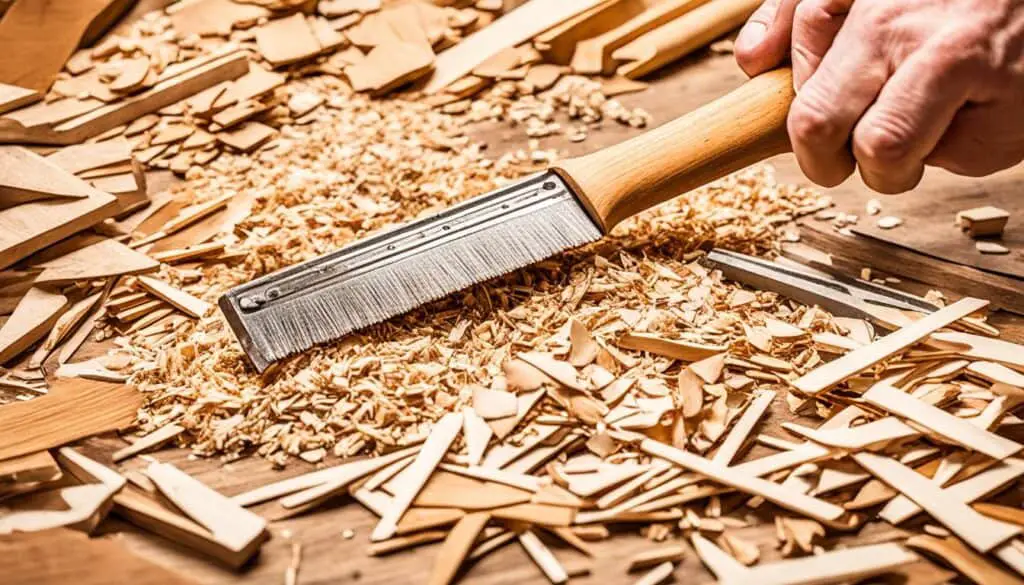
Wood Scraper Maintenance and Storage
Proper maintenance and storage of your wood scrapers are essential for their longevity and performance. By following these maintenance tips, you can ensure that your wood scrapers are always in optimal condition for your woodworking projects.
Maintenance Tips:
- Clean after each use: After using your wood scraper, remove any accumulated debris by wiping the blade with a clean cloth or brush. This helps prevent the build-up of residue that can affect the scraping performance.
- Sharpen the blade: Periodically sharpen the blade of your wood scraper to maintain its effectiveness. Depending on the type of scraper, you can use a sharpening stone or a honing guide to restore the cutting edge. Follow the manufacturer’s instructions for best results.
- Check for damage: Regularly inspect your wood scraper for any signs of damage or wear. If you notice any cracks, chips, or dullness, it may be time to replace the blade or the entire scraper. Using a damaged tool can negatively impact your woodworking results.
- Apply rust protection: To prevent rust and corrosion, apply a thin layer of rust inhibitor or oil to the metal parts of your wood scraper. This helps protect the tool during storage and ensures it remains in good working condition.
Storage Tips:
- Store in a dry place: Avoid storing your wood scraper in a damp environment, as moisture can lead to rust and damage. Find a dry area in your workshop or toolbox to keep the scraper protected.
- Avoid contact with other tools: When storing your wood scraper, make sure it is not in direct contact with other tools or sharp objects that can cause damage. Use a separate compartment or protective case if available.
- Organize and secure: Keep your wood scrapers organized and secured to prevent accidental damage or misplacement. Consider using tool racks, hooks, or dedicated storage solutions to maintain order in your workshop.
“Proper maintenance and storage of wood scrapers are essential for their longevity and performance.”
By implementing these maintenance and storage practices, you can extend the lifespan of your wood scrapers and ensure they are always ready for use. Taking care of your woodworking tools demonstrates your commitment to your craft and helps you achieve excellent results in your woodworking projects.
| Benefits of Wood Scraper Maintenance and Storage | Consequences of Neglecting Maintenance and Storage |
|---|---|
| 1. Prolongs the lifespan of the wood scraper | 1. Reduced performance and efficiency |
| 2. Maintains the sharpness and effectiveness of the blade | 2. Increased risk of accidents and injuries |
| 3. Prevents rust and corrosion | 3. Damage to the wood scraper due to moisture |
| 4. Saves money on frequent replacements | 4. Extra expenses for purchasing new tools |
Conclusion
Wood scrapers are versatile and essential woodworking tools that are designed for efficient paint removal and precise shaping. With the right wood scraper, you can achieve a smooth and flawless finish on your woodwork, whether you are a professional woodworker or a DIY enthusiast.
By investing in high-quality wood scrapers, you can enhance the efficiency and quality of your woodworking projects. These hand tools are specifically designed for stripping away paint, varnish, and other coatings from wooden surfaces, as well as shaping and smoothing wood. Unlike sandpaper or abrasive tools, wood scrapers remove material efficiently without creating dust or damaging the wood fibers.
When choosing a wood scraper, consider factors such as size, shape, and material of the scraper blade. Additionally, look for comfort and grip in the handle, and consider any additional features or accessories that may come with the wood scraper. By carefully selecting the right wood scraper for your specific needs, you can achieve optimal results and enjoy the benefits of efficient stripping and shaping in your woodworking projects.
So, whether you are working on a professional project or a DIY woodworking endeavor, make sure to include a high-quality wood scraper in your toolkit. Embrace the versatility and efficiency that wood scrapers offer, and take your woodworking skills to the next level. Happy woodworking!
FAQ
What are wood scrapers used for?
Wood scrapers are used for scraping away paint, varnish, and other coatings from wooden surfaces, as well as for shaping and smoothing wood.
What are the types of wood scrapers?
The two most common types of wood scrapers are hand-held scrapers and cabinet scrapers.
What factors should I consider when choosing a wood scraper?
Factors to consider when choosing a wood scraper include the size and shape of the scraper, the material of the scraper blade, the handle’s comfort and grip, and any additional features or accessories.
What are some recommended wood scrapers for efficient stripping?
Some recommended wood scrapers for efficient stripping include [List of recommended wood scrapers for efficient stripping].
What are some recommended wood scrapers for precise shaping?
Some recommended wood scrapers for precise shaping include [List of recommended wood scrapers for precise shaping].
What are the differences between wood scrapers and sandpaper?
Wood scrapers offer efficient material removal, minimal dust production, and no heat generation, making them ideal for delicate woodwork. Sandpaper provides a smooth finish and is great for fine sanding and polishing.
How do I maintain my wood scrapers?
To maintain your wood scrapers, you should clean them after use, remove any rust or debris, and periodically sharpen or replace the scraper blades.
What are some wood scraping tips and techniques?
Some wood scraping tips and techniques include using proper hand placement, applying even pressure, and using a combination of scraping directions for the best results.
Are there specific wood scrapers for different wood types?
Yes, there are specific wood scrapers recommended for different wood types, such as [List of wood scrapers for different wood types].
What are some recommended wood scrapers for beginners?
Some recommended wood scrapers for beginners include [List of recommended wood scrapers for beginners].
What are some safety tips for using wood scrapers?
Some safety tips for using wood scrapers include wearing protective gloves and goggles, using the scraper in the correct direction, and keeping your hands away from the blade.
What are some recommended wood scrapers for professional woodworkers?
Some recommended wood scrapers for professional woodworkers include [List of recommended wood scrapers for professional woodworkers].
What are some recommended wood scrapers for DIY enthusiasts?
Some recommended wood scrapers for DIY enthusiasts include [List of recommended wood scrapers for DIY enthusiasts].
How should I maintain and store my wood scrapers?
To maintain and store your wood scrapers, you should clean them before storage, avoid exposure to moisture, and keep them in a dry and organized space.
Why are wood scrapers essential for woodworking?
Wood scrapers are essential tools for efficient paint removal and precise shaping in woodworking projects, allowing woodworkers to achieve a smooth and flawless finish on their woodwork.


